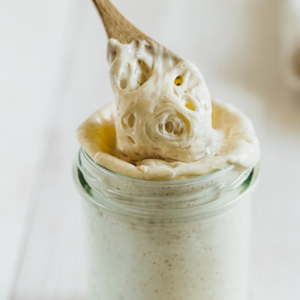
Sourdough Starter Tips and Definitions
Instructions
Tips
- Feed higher portions of water and Manny’s Choice Flour to increase volume faster.Frequent/Daily Use: When using your starter in recipes, always remember to reserve some for your continuing culture. If you plan to use it frequently, keep it in a warm place and continue with daily feedings.Less Frequent/Weekly Use: Store the culture in the refrigerator in a covered jar or container. This will put your starter to “sleep”, requiring less attention until you’re ready to use it again. While refrigerated, feed your starter every week or two to keep it happy. Remember – it will take a day or two for your culture to bounce back from refrigeration. Feed regularly until active again!
Definitions:
- Feeding: Equal portions water and flour – directions: take half of the growing starter out and add equal portions water and flour (ex. Add ¼ cup water and ¼ cup flour to existing ½ cup of starter).Sleeping: "Sleeping" refers to a state of slowed down activity. The starter isn't dead, but rather its natural yeast and bacteria have become less active due to cooler temperatures. This typically happens when you store your starter in the refrigerator.Starter: A fermented mixture of flour and water that cultivates wild yeasts and beneficial bacteria. These yeasts and bacteria leaven (cause to rise) and add flavor to sourdough bread.Culture: This is a commercially available dehydrated or freeze-dried version of naturally occurring yeast and bacteria strains found in sourdough starters. In essence, it's like a snapshot of a mature sourdough starter.Bloom/Grow: When you feed your starter with fresh flour and water, the wild yeasts and bacteria go into high gear. They consume the new sugars in the flour, multiplying and producing carbon dioxide gas as a byproduct.Signs of a Bloom: A blooming starter will exhibit several telltale signs:•Increased Volume: The starter will rise noticeably in its container, often doubling or even tripling in size.•Bubbling: You'll see lots of bubbles throughout the mixture, both large and small. The surface might also become foamy.•Domed Shape: The top of the starter may develop a dome shape due to the trapped gas produced by the active yeasts.Importance of Blooming: Blooming is a crucial stage for several reasons:•Optimal Performance: A blooming starter indicates it's at its peak activity level. This translates to the best performance when used in baking. The starter will produce the most gas, leading to a good rise in your sourdough bread.•Sourdough Flavor: During blooming, the bacteria also produce lactic acid, which contributes to the characteristic tangy flavor of sourdough bread.
- Distinguishing Bloom from Overfeeding: While blooming is a good thing, it's important not to overfeed your starter. Overfeeding can lead to a starter that's too runny and doesn't achieve a proper peak. Here are some tips to differentiate:•Timing: A healthy starter typically blooms within a few hours of feeding, depending on the temperature and feeding ratio.•Consistency: A bloomed starter will still have a spreadable consistency, not overly liquid.By observing the signs of blooming, you can learn to identify the ideal time to use your starter for baking delicious sourdough bread.Waking Up: Waking up a sourdough starter simply means bringing it back to life and activity after a period of dormancy. Since sourdough starters are living cultures, they slow down considerably when stored in cool temperatures like the refrigerator.Activated: A homemade sourdough starter that has been fed recently and is at its peak activity level. It's essentially "awake" and ready to perform its best in sourdough bread baking.Discard: The practice of removing a portion of your starter before feeding it with fresh flour and water. Can be an essential part of maintaining a healthy and manageable sourdough starter.
Tried this recipe?Let us know how it was!

